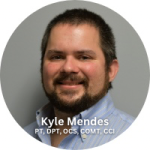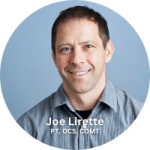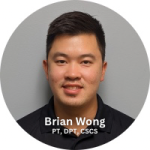



Renew Physical Therapy is the proud home of multiple Titleist Performance Institute-certified physical therapists. TPI certification signifies excellence and expertise in analysis of how the body functions in relation to a person’s golf swing. Renew Physical Therapy is excited to be offering a Golf Rehab Program, with an aim to partner with various clubs in the area. Stay tuned for details!
To learn more about our Golf Rehab Program, we sat down with a few of our therapists. Let’s hear directly from Kyle Mendes, PT, DPT, OCS, COMT, CCI, Joe Lirette, PT, OCS, COMT from our Renew Physical Therapy clinic in Hillman City/Columbia City, Brian Wong, PT, DPT, CSCS from our Beacon Hill clinic, and Chip Moran, PTA from our Renton clinic, as they share their insights.
What is your experience with golf and what are your qualifications for treating golfers?
- Kyle: I’ve been golfing since I was in about the seventh grade with more of a focus now in my 30s. My qualifications include the various sports in my background and strength and conditioning background, as well as the TPI certification levels 1-3.
- Joe: I started playing golf when I was around 13 years old, but didn’t receive any formal instruction until my mid-20’s. Thus, I have been playing golf for almost 40 years. I have had many lessons over the years from many instructors. I play about 25 rounds/year and practice about 2x/week. I also worked for several years as a physical therapist in Arizona and had the opportunity to work both with professional golfers and clients of PGA teaching professionals.
- Chip: I have my Level 1 certification through the Titleist Performance Institute and use these concepts with the Functional Movement Screen to assess patients and golfers.
- Brian: I started playing golf as a teenager and have been obsessed with it ever since. After physical therapy school, I completed golf-specific continuing education courses through the Titleist Performance Institute and the National Academy of Sports Medicine. This has helped me better understand the biomechanics of the golf swing and develop treatment plans specific to golfers.
Are there any key assessment methods or measures you use to evaluate a golfer’s physical condition and target areas for improvement?
- Kyle: Full body movement screen with particular motions that are correlated to dysfunction, specifically in the golf swing, as well as my own orthopedic examination. I like to see videos of their swing in full action as slow practice swings often hide faults.
- Joe: First, any previous surgeries or chronic conditions are extremely important to know – a golfer may need to make slight modifications to the set-up and/or swing mechanics if this is the case. In general, I do a thorough full body mechanical examination as any component from the feet anchoring the ground all the way up to the head can affect the golf swing.
- Chip: In addition to the TPI screen, I use the Functional Movement Screen (FMS) and Select Functional Movement Assessment (SFMA) formats to find functional movement deficits. Once that is determined, I am able to map out a program.
- Brian: I utilize a comprehensive physical screen to assess a golfer’s movement patterns. I look to see how the shoulders, wrists, torso, hips, and pelvis are moving as well as test strength, stability, and coordination of specific muscles.
What can someone expect if they come for a golf swing assessment?
- Kyle: Prepare to discover faults you may not be aware of and while not every fault is a problem, more often than not it’s factoring into your detrimental play or physical complaint if you’re injured. Even the pros have faults, and some pretty heinous faults, but they can accommodate around that, whereas we amateurs aren’t as good at that.
- Joe: In my experience, as both golfer and physical therapist, approximately half of the challenges golfers encounter stem from their initial setup to address the ball. With this in mind, I would look first at your spine angle and any factors that might interfere with an efficient body turn. Other things to consider: Are you limited in your thoracic spine? Can you load your trail hip sufficiently? Can you transfer your weight from your trail hip to your forward hip with a balanced follow through? Finally, how is your balance? Are we able to improve your stability during the weight transfer? The possibilities are endless!
- Brian: I will also look for swing characteristics of golf swing via video analysis or live demonstration. I look at posture, swing plane, and impact position and how they relate to findings of the physical screen.
How do you collaborate with golf coaches and is this the same thing as taking lessons with a pro?
-
- Kyle: I send all my patients with the TPI screen on the app they can share with their coach. I’ve had a few coaches email me directly as well for input on what I’m seeing in the clinic and what drills they’re doing on their end to have our paths align. I approach swing analysis and changes from a risk-benefit analysis and the toll it takes on the body. Their intent is purely performance. I do not sell myself as a performance coach. However, you will find that when implementing efficiency changes for the body, performance usually follows.
- Joe: My primary job as a physical therapist is to treat measurable physical impairments. This may be in the form of impaired range of motion, strength, power, balance, stamina, endurance, or coordination. My job is NOT to try and change or correct every aspect of a player’s swing. Golf professionals are trained specifically in that regard. No matter what, the goal of the golfer is always the most important factor to consider. I have found video, especially on the cell phone, to be extremely beneficial. A short video summary is very easy to do to demonstrate exercises or activities the golfer is working on and progressing through.
- Brian: I work collaboratively with golf coaches, not as a substitute for golf lessons. I help improve strength, flexibility, and stability needed to execute proper swing mechanics. I can translate your physical capabilities to your coach, allowing them to tailor their instruction accordingly.


